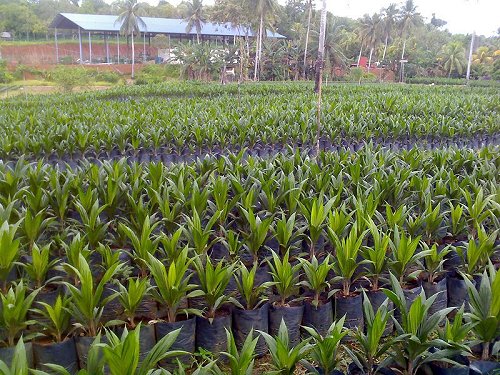
 Sabindo Hawker Center, Tawau
Sabindo Hawker Center, Tawau https://commons.wikimedia.org/wiki/File:SabindoHawkerCenter.jpg
https://commons.wikimedia.org/wiki/File:SabindoHawkerCenter.jpg Oscark
Oscark
Tawau (GPS: 4.24465, 117.89118) is a town on the southeast coast of Sabah. With a population of around 345,000 (2007 est), it is the third largest town in Sabah after Kota Kinabalu and Sandakan. Bugis people make up the majority of the population of Tawau, followed by Chinese (12%), Bajau (8%) and Malays (5%). Like many of the towns in Sabah, Tawau has a substantial number of non-registered Filipino and Indonesian immigrants.
Map of Tawau
Sights in Tawau
- Balung River Eco Resort
- Bukit Gemok (GPS: 4.3209, 117.86933)

- Eastern Plaza (GPS: 4.25446, 117.89649)

- Hospital Tawau (GPS: 4.2463, 117.88037)

- Ibu Pejabat Polis Daerah Tawau (GPS: 4.2463, 117.88037)

- Pasar Ikan Tawau (GPS: 4.24224, 117.88382)

- Pasar Tanjung Tawau (GPS: 4.24317, 117.88478)

- Tawau Airport (GPS: 4.31422, 118.11452)

- Tawau Golf Club (GPS: 4.26436, 117.88127)

- Tawau Hills Park (GPS: 4.40139, 117.88915)

- Tawau Monument (GPS: 4.2463, 117.88037)

- Tawau Yacht Club (GPS: 4.24933, 117.87786)

- Teck Guan Cocoa Museum (GPS: 4.2673, 117.8745)

Sights visited from Tawau
Tawau comprises three areas namely Sabindo, Fajar and Tawau Lama. Most of the government administrative buildings are located in Sabindo. Fajar is the commercial area where most of the banks are located. The original part of Tawau, now called Tawau Lama or "Old Tawau", is where the central market is located. The location of Tawau being in North Borneo was agreed between the governments of Great Britain and the Netherlands in 1915.
Tawau was a town that gained prosperity from commodities, primarily rubber, manila hemp and coconut. In the 1930's the main road was Dunlop Street, named after the district officer A.R. Dunlop. Most of the shophouses along the street were owned by the Chinese who run small holdings, sundry shops and coffee shops. The Pan Borneo Highway passes through it linking Tawau with the rest of Sabah, along with Sarawak and Brunei, on its way to the border with Kalimantan, Indonesia.
 Tawau Oil Palm Nursery
Tawau Oil Palm Nursery https://commons.wikimedia.org/wiki/File:Tawau_Oil_Palm_Nursery.jpg
https://commons.wikimedia.org/wiki/File:Tawau_Oil_Palm_Nursery.jpg Oscark
Oscark
Tawau is still prosperous town today whose economy is supported by tobacco, cocoa and palm oil plantations. Tawau is the reason Malaysia is the world's third largest producer of cocoa beans after Ivory Coast and Ghana. Tawau is also the seaport for high-grade fishes and tiger prawns for overseas markets including Singapore, Hong Kong, Taiwan and Japan.
History of Tawau
Tawau has been documented as early as 1893, although the records of the British North Borneo Company places its official founding in 1898. The early inhabitants of Tawau were refugees from Bulungan and Tawi-Tawi who migrated from Dutch-rule Kalimantan. Tawau largely escaped World War I but suffered under three years of Japanese Occupation in World War II. The district officer of Tawau at that time, Cole Adam, was arrested by the Japanese and was a prisoner-of-war for forty-four month. He passed away on the very day of his release by Allied forces in September, 1945.Getting there
By PlaneMalaysia Airlines and AirAsia have regular flights to Tawau International Airport (TWU) from Kota Kinabalu and Kuala Lumpur. There is an airport bus service to the city. The fare is RM10. It is operated by Kasah Transport, tel: 089 950208.
By Road
The journey from Kota Kinabalu to Tawau takes nine hours. There are daily bus services to Tawau from Kota Kinabalu's North City Bus Station. The fare is about RM60.00. By Ferry
There are ferry connections between Tawau and Nunukan and Tarakan, both in East Kalimantan, Indonesia. The fare to Nunukan is app. RM45 for a one-way trip that takes about 1 hour while the fare to Tarakan is RM140 for a three-hour journey.
Places to eat in Tawau
- Sabindo Hawker Centre
- Makanan Laut 101
- Kam Ling Seafood, tel: 089 756457
What to eat in Tawau
- Kuih Pandan - Pandan rice cakes
- Nasi Kuning - rice cooked with coconut milk and tumeric
- Pisang Goreng - Banana fritters
- Sulawesi Soto Makassar - Buffalo soup
- Ubi Goreng - Tapioca fritters
Tawau on Google Street View
Pasar Ikan Tawau (Jan 2015)Tawau is  on the Map of Sabah
on the Map of Sabah
Back to Discover Sabah mainpage
 Latest updates on Penang Travel Tips
Latest updates on Penang Travel Tips
 Discover with Timothy videos on Sabah
Discover with Timothy videos on Sabah
What to see when in Sabah? Here are some suggestions from my videos.Disclaimer
Please use the information on this page as guidance only. The author endeavours to update the information on this page from time to time, but regrets any inaccuracies if there be any.About this website

Dear visitor, thank you so much for reading this page. My name is Timothy Tye and my hobby is to find out about places, write about them and share the information with you on this website. I have been writing this site since 5 January 2003. Originally (from 2003 until 2009, the site was called AsiaExplorers. I changed the name to Penang Travel Tips in 2009, even though I describe more than just Penang but everywhere I go (I often need to tell people that "Penang Travel Tips" is not just information about Penang, but information written in Penang), especially places in Malaysia and Singapore, and in all the years since 2003, I have described over 20,000 places.
While I try my best to provide you information as accurate as I can get it to be, I do apologize for any errors and for outdated information which I am unaware. Nevertheless, I hope that what I have described here will be useful to you.
To get to know me better, do follow me on Facebook!
Copyright © 2003-2025 Timothy Tye. All Rights Reserved.

 Go Back
Go Back